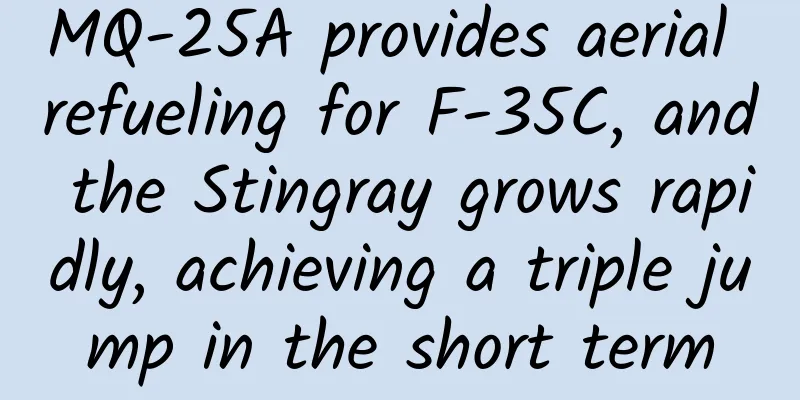MQ-25A provides aerial refueling for F-35C, and the Stingray grows rapidly, achieving a triple jump in the short term

|
The MQ-25 test aircraft, known as T1, conducted its first aerial refueling test flight of an F-35C Lightning II fighter near the Mid-America Airport in Mascoutah, Illinois, on September 13, 2021. Note that the U.S. Navy uses a hose to refuel. A Boeing MQ-25A T1 unmanned carrier tanker refueled an F-35C Illuminating II Joint Strike Fighter as part of early testing of the program, the Naval Air Systems Command announced Tuesday. The "Salty Dog" F-35C assigned to Air Test and Evaluation Squadron (VX) 23, along with the MQ-25 unmanned tanker, took off from MidAmerican Airport in Mascoutah, Illinois, for a test flight near Boeing's facilities in St. Louis. The fighter and the prototype Stingray drone tanker "conducted formation evaluation, wake measurements, refueling drogue tracking, and docked with the MQ-25 test aircraft at 220 kts (407.44 km/h) calibrated airspeed (KCAS) and 10,000 ft (3,048 m). An air vehicle operator then initiated a fuel transfer from the T1 aerial refueling pod to the F-35C from a ground control station, according to a statement from Naval Air Systems Command (NAVAIR). Prior to this aerial refueling test, an F/A-18F Super Hornet fighter jet conducted a test in June and an E-2D Advanced Hawkeye early warning aircraft conducted a test last month. On June 7, 2021, the U.S. Naval Air Systems Command and Boeing issued a statement that the MQ-25 "Stingray" unmanned tanker T1 prototype successfully carried out its first aerial refueling for an F/A-18 F carrier-based fighter. On August 18, 2021, a U.S. Navy E-2D Hawkeye early warning aircraft completed an aerial refueling test with an MQ-25 drone. Including this time's F-35C, the three main combat aircraft models on the US Navy's aircraft carriers have now completed aerial refueling tests with the MQ-25. The progress is still very fast, which also shows the importance the US Navy attaches to this project. "Following this flight, T1 will enter a modification period to integrate the (aircraft carrier) deck handling system in preparation for a shipboard demonstration this winter. So far, T1 has performed 36 flights, providing the project with valuable information on aerodynamics, propulsion, guidance and control before the delivery of the MQ-25 engineering and manufacturing development aircraft," said the U.S. Naval Air Systems Command (NAVAIR). As unmanned tanker capabilities increase, the need for manned tankers decreases, thereby increasing the additional service life and capability of manned strike fighters available for combat missions. F/A-18 carrier-based aircraft conduct buddy refueling operations. According to the US Navy itself, these "Super Hornet" fighter fleets have actually become tankers for the aircraft carrier air wing. Up to 25% to 30% of the flight time of the "Super Hornet" fighter is used as a tactical tanker for the air wing. This is equivalent to reducing the fighters available for air defense or attack missions in disguise. Once the MQ-25 is put into use, these "Super Hornets" can be saved for combat missions, thereby improving the combat capability of the aircraft carrier. The Stingray drone will deliver up to 15,000 pounds of fuel up to 500 nautical miles from the carrier and will relieve the existing Super Hornet fleet of tankers, according to U.S. Naval Institute News. The MQ-25 is being demonstrated on a deck loading and unloading from an aircraft carrier in Norfolk, Virginia, which will be the last set of tests for a prototype Boeing built in 2014 while bidding on the canceled Unmanned Carrier Launched Airborne Surveillance and Strike (UCLASS) program. The company repurposed the airframe for aerial refueling missions and won an $805 million contract in 2018 to build the first four Stingrays in a competition that also included General Atomics and Lockheed Martin (neither of which ever built a prototype). Last year, the Navy executed an $84.7 million contract to buy three more Stingrays, with the goal of having a fleet of 76 at a cost of $1.3 billion. It is planned to declare the MQ-25A to have initial operational capability (IOC) in 2025. The MQ-25 unmanned tanker is an important part of the U.S. Navy's future combat system. The MQ-25 is a bit like the unmanned refueling airship in "Top Secret Flight". The Engineering and Manufacturing Development (EMD) model will enter the fleet next year and, unlike the prototype, will be fully capable of operating at sea. The aircraft will be incorporated into the carrier air wing's E-2D AWACS and carrier-based aircraft delivery units. The fleet replacement squadron, Unmanned Launch Multi-Mission Squadron (VUQ) 10, will be established later this year, followed by the carrier-based Unmanned Launch Multi-Mission Squadron (VUQ)-11 and Unmanned Launch Multi-Mission Squadron (VUQ)-12. On future aircraft carriers, it is a general trend to use drones to replace some special aircraft and even fighter aircraft, such as unmanned early warning aircraft, unmanned tankers and unmanned wingmen. The ratio of manned to unmanned aircraft in the US Navy may be 4:6 in the future. An F-35C Lightning II from Strike Fighter Squadron (VFA) 147, the "Argonne Heroes" (left), an F/A-18F Super Hornet from Strike Fighter Squadron (VFA) 2, the "Bounty Hunters" (center), and an F/A-18E Super Hornet from Strike Fighter Squadron (VFA) 113, the "Ghost Bugs" (right), on the flight deck of the aircraft carrier USS Carl Vinson (CVN-70). U.S. Navy photo. The U.S. Navy is not very interested in the F-35C. It currently only has one squadron as shown in the picture above (the Carl Vinson carrier-based fighter has one F-35C squadron and three F/A-18E/F squadrons). It is more looking forward to the next-generation air superiority fighter + drone combination. At the same time, Boeing also has ambitions to add other functions to the MQ-25 to compete for related projects of the US Navy's "loyal wingman". For example, Boeing has stated that the first updated iteration of the MQ-25 platform also has some intelligence, surveillance and reconnaissance capabilities. It is expected that these capabilities will grow over time and may even be used as a weapon launch platform in the future. The MQ-25A can taxi and take off autonomously. Once it is integrated onto an aircraft carrier, it will quickly adapt to the new combat environment. In addition, the MQ-25 is actually quite large, although it may not be noticeable from a single glance. |
<<: What is the relationship between Chang'e, Houyi and Wu Gang?
Recommend
Motorola President: Lenovo will fully support Moto's future development
Beijing time, September 8, noon news, Motorola Mo...
Can AI meet human emotional needs?
With the continuous advancement of science and te...
Why is Erlitou the Summer Capital? Traveling 5,000 years to explore China's "First Dynasty"
One day 4000 years ago The mythical hero Dayu Pas...
Jobs' Fence
[[136824]] How did Jobs develop his pursuit of su...
For online operation and promotion, can the hit H5 that goes viral be replicated?
In the past two years, we have seen H5s produced ...
How do animals become "love masters" every spring?
"Spring is here, everything is revived, and ...
Firefly fossils were found in Burmese amber about 100 million years ago. What kind of light would they emit?
Author: Shi Xiangqi and Li Chuanfu Under the brig...
Harnessing the miracle of life: Tracing the birth of the first test-tube baby in mainland China丨Today in the history of science and technology
On March 10, 1988, the first test-tube baby was b...
This toxin has a carcinogenic risk! It is actually related to the tomatoes you often eat
Tomatoes are rich in nutritional value, eating to...
13 kinds of excellent app designs not only have design aesthetics, but also track user experience
【51CTO.com Quick Translation】We have always been ...
Dawn! The world's first successful launch of a liquid oxygen-methane rocket
At around 9:00 a.m. on July 12, the Suzaku-2 Yao-...
B station operation and traffic diversion strategy!
Let me first briefly introduce Bilibili, or B Sta...
How to promote and attract traffic to Guangzhou mini programs? How to promote and attract traffic to Guangzhou mini programs?
Recently, many customers have asked me what to do ...
Tips for preventing malicious clicks in SEM promotion!
Those of us who do SEM promotion know that each k...
GM recalls some Envision and Cadillac CT6 vehicles
According to the official website of the State Ad...









